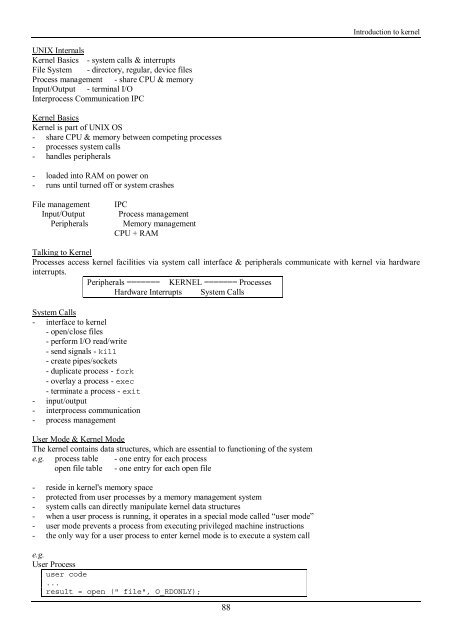You also want an ePaper? Increase the reach of your titles
YUMPU automatically turns print PDFs into web optimized ePapers that Google loves.
Introduction to kernel<br />
UNIX Internals<br />
Kernel Basics - system calls & interrupts<br />
File System - directory, regular, device files<br />
Process management - share CPU & memory<br />
Input/Output - terminal I/O<br />
Interprocess Communication IPC<br />
Kernel Basics<br />
Kernel is part of UNIX <strong>OS</strong><br />
- share CPU & memory between competing processes<br />
- processes system calls<br />
- handles peripherals<br />
- loaded into RAM on power on<br />
- runs until turned off or system crashes<br />
File management<br />
Input/Output<br />
Peripherals<br />
IPC<br />
Process management<br />
Memory management<br />
CPU + RAM<br />
Talking to Kernel<br />
Processes access kernel facilities via system call interface & peripherals communicate <strong>with</strong> kernel via hardware<br />
interrupts.<br />
Peripherals ======= KERNEL ======= Processes<br />
Hardware Interrupts System Calls<br />
System Calls<br />
- interface to kernel<br />
- open/close files<br />
- perform I/O read/write<br />
- send signals - kill<br />
- create pipes/sockets<br />
- duplicate process - fork<br />
- overlay a process - exec<br />
- terminate a process - exit<br />
- input/output<br />
- interprocess communication<br />
- process management<br />
User Mode & Kernel Mode<br />
The kernel contains data structures, which are essential to functioning of <strong>the</strong> system<br />
e.g. process table - one entry for each process<br />
open file table - one entry for each open file<br />
- reside in kernel's memory space<br />
- protected from user processes by a memory management system<br />
- system calls can directly manipulate kernel data structures<br />
- when a user process is running, it operates in a special mode called “user mode”<br />
- user mode prevents a process from executing privileged machine instructions<br />
- <strong>the</strong> only way for a user process to enter kernel mode is to execute a system call<br />
e.g.<br />
User Process<br />
user code<br />
...<br />
result = open (" file", O_RDONLY);<br />
88
















